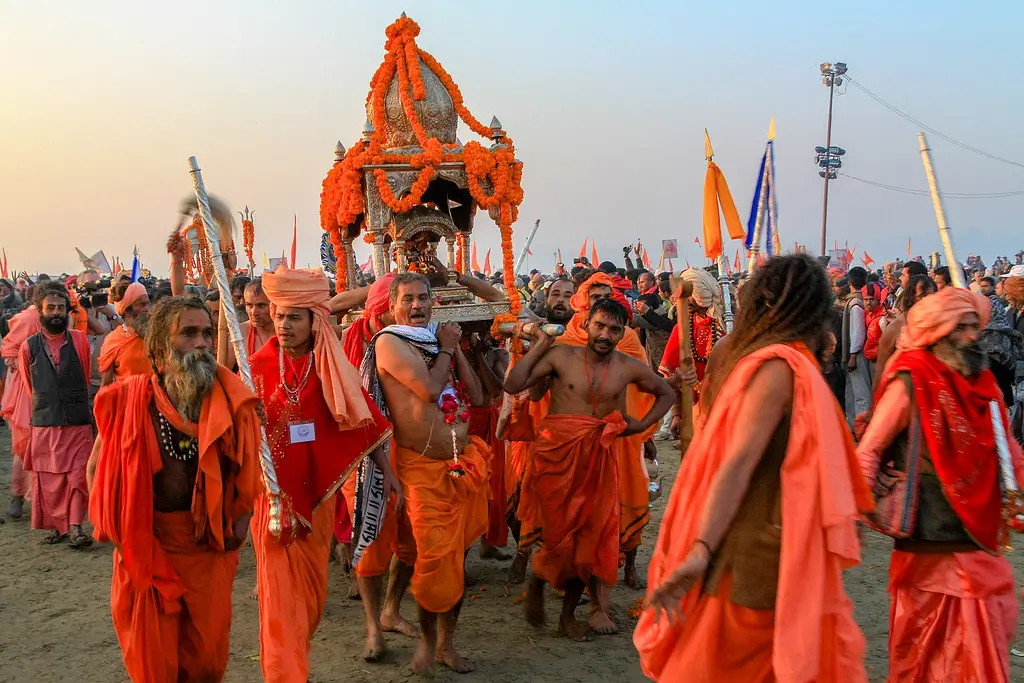Table of Contents:
Mahakumbh 2025: The Ultimate Guide to a Spiritual Sojourn in Prayagraj
Nestled in the heart of Uttar Pradesh, Prayagraj—formerly known as Allahabad—holds a sacred position in India’s spiritual geography. Crowned as Tirthraj (the King of Pilgrimages), this ancient city is home to the Mahakumbh Mela, the largest religious gathering on Earth. Mahakumbh 2025 promises a deeply spiritual experience, blending rituals, heritage, and devotion into an unforgettable journey.
Let’s embark on a virtual pilgrimage through this comprehensive itinerary for Mahakumbh 2025, exploring every important destination, sacred ritual, and unique experience Prayagraj has to offer.
Why Visit Mahakumbh 2025?
The Mahakumbh is no ordinary event—it’s a cosmic celebration of faith and spirituality that occurs only once every 144 years. It is believed that during the Kumbh, the divine nectar of immortality spills into the waters of the Triveni Sangam, blessing the pilgrims who bathe here with moksha (liberation). From the royal Shahi Snan to ancient temples and serene ghats, Mahakumbh offers something for every seeker.
Reaching Prayagraj
Prayagraj is well-connected by air, rail, and road, ensuring a hassle-free journey for pilgrims from across India and abroad. Here’s how you can reach the city:
- By Air: The Prayagraj Airport is 12 km from the city center, offering flights from major cities like Delhi, Mumbai, and Kolkata.
-
- Flight Booking Portals: for booking flights to Prayagraj Cleartrip , MakeMyTrip.
-
- By Train: Prayagraj Junction is one of the busiest railway stations in the country, linking the city to all major regions.
-
- official Indian Railways website for booking train tickets to Prayagraj link
-
- By Road: Numerous buses and private taxis operate from cities like Varanasi, Kanpur, and Lucknow.
Where to Stay?
Accommodation in Prayagraj during the Mahakumbh can be a challenge due to the massive influx of visitors. Hotels range from ₹5,000–₹7,000 per night, depending on their proximity to the Sangam area. However, the Government of India has introduced affordable options in the form of Jan Ashraya shelters located near the Kumbh grounds. These shelters cost just ₹1 for 24 hours, offering basic amenities for budget travelers.
Pro Tip: Book your stay well in advance and prioritize government shelters for affordable and accessible accommodation.
Day 1: The Sacred Dip at Triveni Sangam
Your Mahakumbh journey begins with the most important ritual—the holy dip at Triveni Sangam, the confluence of the Ganga, Yamuna, and the mythical Saraswati rivers. This sacred bath is said to cleanse the soul, wash away sins, and grant spiritual blessings.
How to Reach the Sangam Point:
There are two ways to take a dip:
- At the Ghats: Ideal for those seeking a quick experience, you can complete your ritual within 10–20 minutes.
- By Boat to the Main Sangam:
- Shared Boat: ₹90 per person
- Private Boat: ₹900 for up to 10 people
On Shahi Snan days, boats are unavailable at the main ghats. Instead, use Saraswati Ghat or Arail Ghat to access the Sangam. Safety
Tip: Always wear a life jacket, even if you’re a good swimmer. The waters at the confluence can be very deep.
Pro Tip: Arrive by 5:00 AM to avoid crowds and ensure a serene experience at the Sangam.
Post-Dip Exploration Around Sangam
After completing your holy dip, make the most of your day by visiting the iconic sites surrounding the Sangam:
1. Akshayavat Corridor and Tree
Located near the Sangam, this ancient Akshayavat Tree is believed to be indestructible—even during cosmic destruction. It is said to be a symbol of divine stability and immortality. The newly constructed corridor enhances the spiritual experience of this sacred spot.
2. Patalpuri Temple
Housed within the Akshayavat Corridor, this underground temple is a treasure trove of history and spirituality. It is home to over 40 deities and sages, including idols of Brahma, Vishnu, and Shiva.
3. Reclining Hanuman Temple
Famous for its 20-ft-long idol of Lord Hanuman in a reclining pose, this temple attracts thousands of devotees. It is believed that visiting this temple removes obstacles and fulfills wishes.
4. Adi Shankaracharya Viman Mandapam
A masterpiece of South Indian architecture, this four-story temple is dedicated to Adi Shankaracharya and various deities like Tirupati Balaji and Goddess Kamakshi. From its 130-ft-high tower, you can enjoy breathtaking views of the Kumbh Mela grounds.
Savor the Flavors of Prayagraj
No journey is complete without savoring the local cuisine. Prayagraj offers a unique food trail that satisfies both the soul and the taste buds:
- Dehati Rasgulle: Known for their massive size and incredible softness, these rasgullas are a must-try at ₹50 per piece.
- Jaiswal Dosa Corner: Famous for their Masala Dosa (₹175) and Badam Shake, this spot is a haven for South Indian food lovers.
Pro Tip: Don’t miss the Badam Shake here—it’s pure, refreshing, and unlike anything you’ve tasted before.
Day 2: Temple Hopping and Cultural Immersion
Spend your second day exploring the iconic temples of Prayagraj and soaking in its cultural heritage:
1. Veeni Madhav Temple
Known as Prayagraj’s city deity, Lord Vishnu resides here. This temple holds immense historical and spiritual significance.
2. Nag Vasuki Temple
Dedicated to the serpent king Vasuki, this temple is located 1.4 km from Veeni Madhav. Mythology suggests that Vasuki rested here after the Samudra Manthan and performed penance to Lord Vishnu.
3. Alopi Devi Shaktipeeth
One of the 51 Shaktipeeths, this temple has a unique tradition of worshiping a wooden palanquin as the goddess. The absence of an idol makes it one of a kind.
Evening Bliss: The Laser Show
As the sun sets, head to Kali Ghat between the New Yamuna Bridge and Old Naini Bridge for the Laser Show. This spectacular event uses water fountains as a canvas to narrate the legends of Prayagraj and the Triveni Sangam. The show is an immersive experience that leaves visitors in awe.
Day 3: Spirituality Meets Serenity
On your final day, explore some lesser-known yet significant sites:
1. Manakamneshwar Temple
Located near the Sangam, this Shiva temple is known for fulfilling the wishes of its devotees. The serene atmosphere and stunning sunset views over the Naini Bridge make it a must-visit.
2. Shivala Park
Designed in the shape of the Indian map, this park features replicas of the 12 Jyotirlingas and offers a peaceful retreat amidst the bustling Kumbh. Visit during the day to enjoy the intricate architecture and serene vibes.
Important Tips for Your Mahakumbh 2025 Journey
- Travel Light: Carry only essentials like water bottles, snacks, and spiritual items.
- Wear Comfortable Shoes: Expect long walks during your trip, so durable footwear is a must.
- Avoid Plastic: Help keep Prayagraj clean by avoiding single-use plastics.
- Plan Your Route: Use Google Maps or QR codes for navigation.
- Be Respectful: Honor the sanctity of the ghats and temples by following local customs and rules.
Visit Uttar Pradesh Tourism website for information on government initiatives and accommodations during Mahakumbh.
Conclusion: A Journey of a Lifetime
Mahakumbh 2025 is more than a pilgrimage—it’s a transformative journey that connects you to your spiritual roots. From the divine dip at Sangam to temple visits, cultural immersion, and culinary delights, this event is an extraordinary celebration of India’s rich heritage.
Plan your trip, embrace the divine energy of Prayagraj, and return with a heart full of memories and blessings.
Har Har Mahadev!



